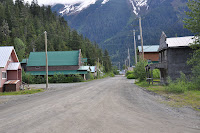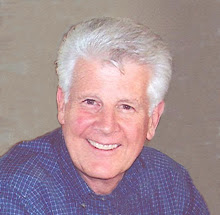Grizzly! And Jade!
We are continuing up the Cassiar highway, which is sort of the back road through Canada to Alaska. The Alaska Highway is the main route, and the Cassiar is to the west of that. It is 450 miles long and is a two-lane road, some gravel, but mostly paved. It has steep drop offs with no shoulders. There is so little traffic. We counted 18 cars in over 150 miles of highway. But the scenery is gorgeous, and the road is ribboned on each side with ---dandelions! They are so bright and add so much color to the blues and greens of the landscape.
One stop we make is at Eddontenajon Lake. It is stunning because of the reflection of the trees, mountains and clouds in the water. John got some great pictures!
We are looking forward to the only two places mentioned on this strip of highway – Iskut and Dease Lake. Both are huge disappointments. Iskut is nothing but a small store. It is owned by the Nahltan Indians. They have diesel, and since they are the only game around, it costs $4.81 a gallon. The receipt said Happy Valentines Day. John tried to make conversation with the woman at the cash register, but when he asked her, ’how’s your day going?” she shrugged! The store featured ketchup-flavored potato chips, which I had never seen before, Old Dutch brand. They had scant produce that looked like it had wintered badly, but two impressive bunches of celery about 5 inches in diameter.
A black bear with a beautiful shiny coat is by the road. I wonder why his coat looks so much better than the other bears we have seen.
Dease Lake, a mere 98 miles up the road from Iskut, is slightly larger. It boasts the Northern Lights college campus that is a single small building. I mention to John that you never see an advertisement for “Mom’s Café” anymore, saying “Home cooked food”. Just as I said that, a sign appeared for “Mama’s Café” featuring home cooked food! Dease Lake was a supply point for the Cassiar gold rush 1872-80.
Right after we left Dease Lake, John spotted a Grizzly! He was foraging by the side of the road, and adopted a menacing stance when we stopped, then proceeded to eat without being bothered by us.
Another bear, this one a black bear with two little ones hightail it when they hear us coming. It is hard to sneak up in a diesel truck! The bears with babies don’t linger!
We hit a lot of gravel road along here, and John is learning how to read the little red “slow’ signs they have placed near the “ice heaves” as they call the potholes and breakups in the road.
The highlight of this stretch of road is Jade City. Jade City consists of two stores, one on either side of the road. They have huge jade cutting equipment outside, and two very friendly young girls staff the Cassiar Mountain Jade store. We had a long conversation about a number of things. They were the ones that told me Hyder was for draft dodgers. I asked them about Queen Victoria Day (it’s today) and they don’t know what it’s a celebration for. They’ll have to “Google" it, they say. Yes, it’s in celebration of Queen Victoria’s birthday. Do they know, I ask, that the current Queen Elizabeth also celebrates her official birthday today? Her real birthday is in the winter, as I recall. You mean she gets to pick her birthday? No, I tell them, she gets two!
The Princess Jade mine in the Cassiar Mountains supplies 90 percent of the world’s Jade! Who knew! They ship it off to Australia, China, Japan and other places for processing into jewelry etc. The clerks keep John busy while I make my purchases. They are looking forward to the summer and lots of tourists. I sure hope they are right for their sakes!
Our stop tonight is Boya Lake. It’s small, and it’s actually jade green! There are jade rocks everywhere, along with rhodenite and quartz and hematite. It’s just like gravel, with some huge boulders at the campsites. We get a beautiful site with the mountains in the distance, and there are red canoes and kayaks on the lake until after 10 pm. I hear fireworks, I guess in celebration of Queen Victoria’s birthday!
PS all the dogs at this site seemed to be named Max. And there are only three campers besides us!
As of today, we’ve gone 3,343 miles! It’s day 20.























































